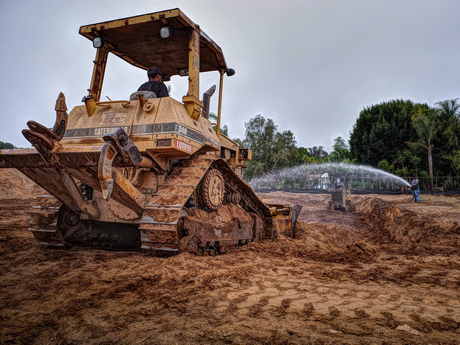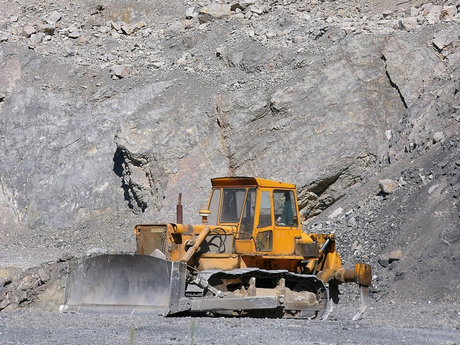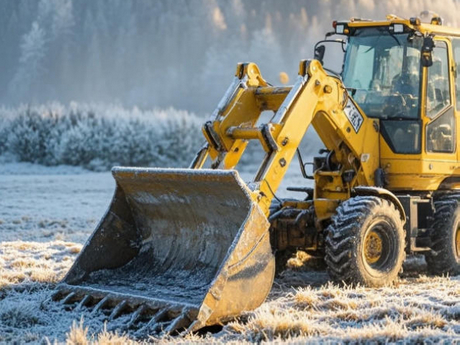As summer approaches, rain is frequent and
the wet environment puts higher requirements on bulldozer operations. In order
to ensure the stable operation of equipment and construction safety, please
focus on the following points:

Pre-construction comprehensive inspection
In summer, frequent rainfall, muddy and
slippery construction areas significantly increase the risk of bulldozer
construction, and a full range of inspections and preparations should be
carried out before operation:
· Construction site risk assessment: survey
the terrain before operation to confirm whether there are waterlogged potholes,
soft ground, landslide risk. If you find loose foundations, unknown depth of
water or the existence of trapped vehicles potential, you should suspend the
operation and deal with it first.
· Vehicle sealing inspection: Focus on
checking whether the cab doors, windows, windshield, instrument panel, etc. are
well sealed to prevent rainwater from seeping in and causing moisture in the
electrical system, rust and corrosion of the equipment and other hidden
dangers.
· Engine system check: make sure the oil
dipstick seal is not aging or broken; check whether the air filter element is
damp to prevent the filtering effect from decreasing; check whether the starter
motor and generator wiring harness connection points are rusted or loose.
· Fuel system water removal: In the
environment of high humidity and frequent temperature difference, water vapor
is easily formed in the fuel tank, which needs to be regularly removed from the
oil-water separator, hydraulic oil tank and other places. It is recommended to
fill up the fuel after daily operation to reduce air residue and avoid
condensation.
Attention to safety and maintenance during
operation
Rainy day operation not only affects the line
of sight, but also increases the load of equipment electricity and mechanical
systems, special attention should be paid to the following matters:
· Limit the height and speed of water-related
operation: the water depth should not exceed the center of the carrier sprocket
to avoid water ingress into the transmission system and track derailment;
control the operation speed, avoid emergency change of direction, and reduce
the risk of getting stuck or sideslip.
· Electrical system protection: keep the
wiring harness dry and check whether the key electrical parts such as fuse box,
electronic control module and sensor interface are well sealed; replace the
aging rubber sleeve or waterproof washer in time.
· Operation path planning: If you find the
ground softening or equipment sinking during the construction, you should stop
the operation immediately and withdraw from the dangerous area; prohibit
blindly trying new routes, and confirm that the path is solid before driving.
· Power system cooling protection: Avoid
splashing water on the radiator or fan blades, so as not to damage the blades
and affect the cooling efficiency of the engine; if water enters into the cabin
while working, it should be stopped immediately.

Standardized parking after closing
Downtime maintenance under high humidity
environment in rainy season is directly related to the service life of the
bulldozer and the smooth operation of the next day's work:
· Disconnect the main power switch: only
turning off the key switch will leave part of the electrical system in standby
mode, which will drain the battery in the long term and pose a short-circuit
hazard. Be sure to disconnect the power completely to ensure safety.
· Cleaning and drying treatment: After operation,
you need to flush the chassis system, tracks, guide wheels, floating oil seals
and other areas that are prone to mud accumulation, wipe off the water on the
surface and apply antirust grease to prevent bearing wear due to erosion of mud
and sand.
· Check the oil drain port and liquid level:
make sure the oil drain bolts of each system are not loosened and there is no
leakage; check the oil and hydraulic oil level and whether the oil is damp and
deteriorated in time.
· Reasonable choice of parking point: avoid
parking in the mountains, riverside or possible waterlogged areas, give
priority to areas with high terrain, good ventilation and smooth drainage; make
sure to cover with rainproof cloth when parked in the open air.
Long-term Storage and Maintenance
Recommendations
If the equipment enters the standby period
or the project is suspended due to the rainy season, the bulldozer needs to be
stored properly to ensure that it can be put into use quickly afterwards:
· Standardize Covering and Support: When storing,
the equipment should be parked on a hardened surface and the entire body should
be covered with rainproof and sunproof materials to avoid deterioration of the
equipment due to wind and rain.
· Regularly start the vehicle: It is
recommended to start the vehicle once a month and run the engine and each
working device for 5~10 minutes to make the oil of each system circulate fully
and keep lubrication to prevent rust and corrosion.
· Air conditioning system operation and
maintenance: Turn on the cooling function and run for 3~5 minutes to lubricate
the compressor, condenser and other parts to prevent aging of seals and
refrigerant leakage.
· Battery maintenance: If parked for a long
time, regular inspection and charging are required; battery terminals should be
coated with antioxidant grease and kept dry to prevent loss of power or
vulcanization and crystallization

The construction environment in the rainy
season is complex and volatile, so the maintenance of equipment should not be
neglected. As the core construction equipment, bulldozers have a direct impact
on operational efficiency and site safety. We hope that the above rainy season
maintenance and use of key points for front-line operators to provide practical
reference to ensure that every operation is safe, efficient and worry-free.






























